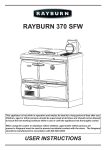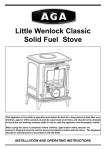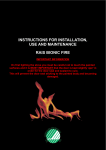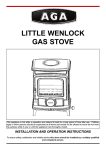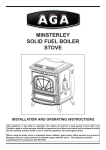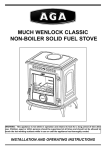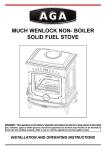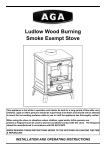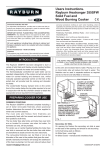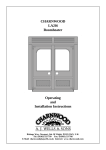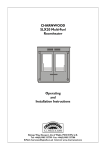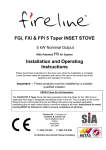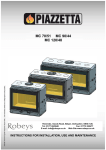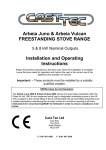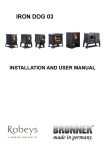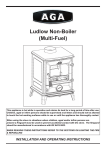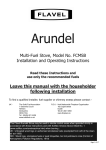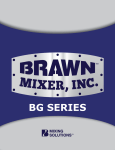Download Aga Ranges Berrington Stove User Manual
Transcript
BERRINGTON SOLID FUEL BOILER STOVE INSTALLATION AND OPERATING INSTRUCTIONS This appliance is hot while in operation and retains its heat for a long period of time after use. Children, aged or infirm persons should be supervised at all times and should not be allowed to touch the hot working surfaces while in use or until the appliance has thoroughly cooled. TABLE OF CONTENTS PAGE NO. 1. General . . . . . . . . . . . . . . . . . . . . . . . . . . . . . . . . . . . . . . . . . . . . . . . . . . . . . . . . . . . . . . 2 2. Pre Installation Assembly . . . . . . . . . . . . . . . . . . . . . . . . . . . . . . . . . . . . . . . . . . . . . . . . . 2 3. Flues . . . . . . . . . . . . . . . . . . . . . . . . . . . . . . . . . . . . . . . . . . . . . . . . . . . . . . . . . . . . . . . . 2 4. Flue Pipes . . . . . . . . . . . . . . . . . . . . . . . . . . . . . . . . . . . . . . . . . . . . . . . . . . . . . . . . . . . . 3 5. Chimney . . . . . . . . . . . . . . . . . . . . . . . . . . . . . . . . . . . . . . . . . . . . . . . . . . . . . . . . . . . . . . 3 6. Down Draughts . . . . . . . . . . . . . . . . . . . . . . . . . . . . . . . . . . . . . . . . . . . . . . . . . . . . . . . . 3 7. Ventilation & Combustion Air Requirements . . . . . . . . . . . . . . . . . . . . . . . . . . . . . . . . . . 3 8. Flue Pipes . . . . . . . . . . . . . . . . . . . . . . . . . . . . . . . . . . . . . . . . . . . . . . . . . . . . . . . . . . . . 4 10. Top Flue Exit . . . . . . . . . . . . . . . . . . . . . . . . . . . . . . . . . . . . . . . . . . . . . . . . . . . . . . . . . . 4 11. Rear Flue Exit . . . . . . . . . . . . . . . . . . . . . . . . . . . . . . . . . . . . . . . . . . . . . . . . . . . . . . . . . 4 12. Floor Protection . . . . . . . . . . . . . . . . . . . . . . . . . . . . . . . . . . . . . . . . . . . . . . . . . . . . . . . . 5 13. Location . . . . . . . . . . . . . . . . . . . . . . . . . . . . . . . . . . . . . . . . . . . . . . . . . . . . . . . . . . . . . . 5 14. Installation Clearances . . . . . . . . . . . . . . . . . . . . . . . . . . . . . . . . . . . . . . . . . . . . . . . . . . 5 15. Specification . . . . . . . . . . . . . . . . . . . . . . . . . . . . . . . . . . . . . . . . . . . . . . . . . . . . . . . . . . . 6 16. Technical Data . . . . . . . . . . . . . . . . . . . . . . . . . . . . . . . . . . . . . . . . . . . . . . . . . . . . . . . . . 6 17. Plumbing . . . . . . . . . . . . . . . . . . . . . . . . . . . . . . . . . . . . . . . . . . . . . . . . . . . . . . . . . . . . . 7 18. Regulations . . . . . . . . . . . . . . . . . . . . . . . . . . . . . . . . . . . . . . . . . . . . . . . . . . . . . . . . . . . 7 19. Gravity Circuit. . . . . . . . . . . . . . . . . . . . . . . . . . . . . . . . . . . . . . . . . . . . . . . . . . . . . . . . . . 7 20. Injector Tee. . . . . . . . . . . . . . . . . . . . . . . . . . . . . . . . . . . . . . . . . . . . . . . . . . . . . . . . . . . . 7 21. Water Circuit Temperature . . . . . . . . . . . . . . . . . . . . . . . . . . . . . . . . . . . . . . . . . . . . . . . . 7 22. Operating Instructions . . . . . . . . . . . . . . . . . . . . . . . . . . . . . . . . . . . . . . . . . . . . . . . . . . . 7 23. Low / Slumber Burn . . . . . . . . . . . . . . . . . . . . . . . . . . . . . . . . . . . . . . . . . . . . . . . . . . . . . 7 24. Primary Air Control. . . . . . . . . . . . . . . . . . . . . . . . . . . . . . . . . . . . . . . . . . . . . . . . . . . . . . 8 25. Recommended Fuels . . . . . . . . . . . . . . . . . . . . . . . . . . . . . . . . . . . . . . . . . . . . . . . . . . . . 8 26. Important Notes . . . . . . . . . . . . . . . . . . . . . . . . . . . . . . . . . . . . . . . . . . . . . . . . . . . . . . . . 9 27. Lighting. . . . . . . . . . . . . . . . . . . . . . . . . . . . . . . . . . . . . . . . . . . . . . . . . . . . . . . . . . . . . . . 10 28. De-Ashing . . . . . . . . . . . . . . . . . . . . . . . . . . . . . . . . . . . . . . . . . . . . . . . . . . . . . . . . . . . . 11 29. Disposal of Ashes . . . . . . . . . . . . . . . . . . . . . . . . . . . . . . . . . . . . . . . . . . . . . . . . . . . . . . 11 30. To Clean Chimney Outlet . . . . . . . . . . . . . . . . . . . . . . . . . . . . . . . . . . . . . . . . . . . . . . . . . 11 31. To Replace Damaged Grate or Bar . . . . . . . . . . . . . . . . . . . . . . . . . . . . . . . . . . . . . . . . . 11 32. Fire Safety . . . . . . . . . . . . . . . . . . . . . . . . . . . . . . . . . . . . . . . . . . . . . . . . . . . . . . . . . . . . 12 33. In Case of Fire . . . . . . . . . . . . . . . . . . . . . . . . . . . . . . . . . . . . . . . . . . . . . . . . . . . . . . . . . 12 34. Vitreous Enamel Cleaning . . . . . . . . . . . . . . . . . . . . . . . . . . . . . . . . . . . . . . . . . . . . . . . . 12 35. Glass Cleaning. . . . . . . . . . . . . . . . . . . . . . . . . . . . . . . . . . . . . . . . . . . . . . . . . . . . . . . . . 12 36. Glass Replacement . . . . . . . . . . . . . . . . . . . . . . . . . . . . . . . . . . . . . . . . . . . . . . . . . . . . . 12 37. Exploded View . . . . . . . . . . . . . . . . . . . . . . . . . . . . . . . . . . . . . . . . . . . . . . . . . . . . . . . . . 13 1 BERRINGTON SOLID FUEL STOVE INSTALLATION & OPERATING INSTRUCTIONS GENERAL Fig.3 When installing, operating and maintaining your Berrington Stove respect basic standards of fire safety. Read these instructions carefully before commencing the installation. Failure to do so may result in damage to persons and property. Consult your local Municipal office and your insurance representative to determine what regulations are in force. Save these instructions for future reference. The installation must be completed in accordance with current National and European Standards and Local Codes. It should be noted that the requirements and these publications may be superseded during the life of this manual. Fit the primary air control knob to the flexible drive. (for the boiler model, ensure that the air damper knob spacer is placed between the knob and the flexible drive bracket on the back of the boiler). See Fig.3 PRE INSTALLATION ASSEMBLY 1. After removing the stove from its pack, open the ashpit door and remove the contents. 2. Fit the front door handle as shown in Fig.1. FLUES Fig.1 Flues should be vertical wherever possible and where a bend is necessary, it should not make an angle of more than 45o with the vertical. Horizontal flue runs should be avoided except in the case of a back outlet from the appliance, when the length of the horizontal section should not exceed 150mm. In order to minimise flue resistance and to make sweeping easier it is recommended to use 2 x 45o bends rather than a 90o bend. The flue termination point must be located to minimise any wind effects. Wind effects of suction, pressure zones and turbulence can be created by the roof and adjacent objects. Wind effects can also be created by natural land contours. 3. Remove the stove from the wooden pallet. 4. Unscrew the two 1/4” x 1/2” round head screws from the base and fit the front ash tray using the two screws (see Fig.2). To minimise the wind effects, the flue termination point should be located a minimum of 600mm from the roof measured vertically and 2300mm measured horizontally. Where this termination point does not suffice it may be necessary to extend the flue pipe so that the termination point is above the apex. (See Fig.3) Fig.2 2 2300 with a minimum continuous draught of 15 Pascals. Poor draught will result in poor performance. Similarly an excessive draught will result in the appliance over firing or being difficult to control. An excessive draught may require a flue draught stabiliser to be fitted. Do not connect this appliance to a chimney serving another appliance. The minimum required chimney height is 4.5 metres from the floor on which the appliance is installed. An existing masonry chimney should be inspected and if necessary, repaired by a competent mason. 600 Fig.4 DOWN DRAUGHTS Appliance However well designed constructed and positioned, the satisfactory performance of the flue can be adversely affected by down draught caused by nearby hills, adjacent tall buildings or trees. These can deflect wind to blow directly down the flue or create a zone of low pressure over the terminal. A suitable anti-down draught terminal or cowl will usually effectively combat direct down blow but no cowl is likely to prevent down draught due to a low pressure zone. Soot Door VENTILATION & COMBUSTION AIR REQUIREMENTS FLUE PIPES This appliance is rated at no more than 8kW. It is imperative that there is sufficient air supply to the stove in order to support correct combustion. The air supply to this appliance must comply with B.S. 8303: Part 1 and current Building Regulations. The minimum effective air requirement for this appliance is 16.5cm2. A flue pipe should only be used to connect an appliance to a chimney and should not pass through any roof space. Flue pipes may be of any of the following materials: (a) Cast iron as described in BS 41: 1973 (1981), or (b) Mild steel with a wall thickness of at least 3mm, or (c) Stainless steel with a wall thickness of at least 1mm and as described in BS EN 10095: 1999 Specification for stainless and heat resisting steel plate, sheet and strip, for Grade 316 S11, 316 S13, 316 S16, 316 S31, 316 S33, or the equivalent Euronorm 88-71 designation, or (d) Vitreous enamelled steel complying with BS 6999: 1989. If a draught stabiliser is used then this increases to 40.5cm2. When calculating combustion air requirement for this appliance use the following equation: a total free area of at least 550mm2 per kW of rated output above 5kW shall be provided. If there is another air using appliance fitted in the same or adjacent room, it will be necessary to calculate additional air supply. All materials used in the manufacture of air vents should be such that the vent is dimensionally stable and corrosion resistant. Flue pipes with spigot and socket joints should be fitted with the socket uppermost. CHIMNEY The effective free area of any vent should be ascertained before installation. The effect of any screen should be allowed for when determining the effective free area of any vent. The stove is a radiant room heater and must be connected to a chimney of the proper size and type. The chimney must have a cross sectional area of at least 19350 square mm (30 square inches) or a diameter of 150mm (6 “). The chimney should be checked for soundness and draught before installation. The stove must be connected to a chimney Air vents direct to the outside of the building should be located so that any air current produced will not pass through normally occupied areas of the room. An air vent outside the building should not be located less than the dimensions specified within the Building Regulations from any part of any flue terminal. 3 These air vents must also be fire proofed as per Building Regulations. Fig. 5 Air vents traversing cavity walls should include a continuous duct across the cavity. The duct should be installed in such a manner as not to impair the weather resistance of the cavity. Joints between air vents and outside walls should be sealed to prevent the ingress of moisture. Existing air vents should be of the correct size and unobstructed for the appliance in use. If there is an air extraction fan or other air using appliance fitted in the room or adjacent rooms where this appliance is fitted, additional air vents will be required to alleviate the possibility of spillage of products of combustion from the appliance/flue while the fan is in operation. 6” Cast Iron Bend Where such an installation exists, a test for spillage should be made with the fan or fans and other appliances using air in operation at full rate, (i.e. extraction fans, tumble dryers) with all external doors and windows closed. If spillage occurs following the above operation, an additional air vent of sufficient size to prevent this occurrence should be installed. REAR FLUE EXIT For the rear flue outlet configuration, push in the flue connector pipe (not supplied) into the flue outlet socket at the rear of the stove and cement into place using approved fire cement ensuring that no cement blocks the flue passageway. (See Fig.7) FLUE PIPES Fig. 6 Flue pipes with spigot and socket joints should be fitted with the socket upper most. Clearance to combustibles must be adhered to when fitting the flue pipe. The flue gas mass flow is 5.4 g/s mineral fuel and 6.1 g/s wood logs. The mean flue gas temperature directly downstream of the spigot at nominal heat output is 262°C. The appliance is suitable for continuous operation on solid mineral fuel and intermittent operation on wood logs. TOP FLUE EXIT For the top outlet configuration, connect bend (not supplied) into flue outlet socket at the rear of the stove and cement into place using approved fire cement ensuring that no cement blocks the flue passageway. (See Fig. 6) It may be necessary to have an inspection plate in the flue pipe to assist with access for cleaning the flue way. 4 FLOOR PROTECTION It is recommended that this appliance is installed on a solid, level, non combustible hearth conforming to current Building Regulations. Fig.7 The appliance is suitable for continuous operation on solid mineral fuel and intermittent operation on wood logs. This appliance has been tested using seasoned wood logs and manufactured briquetted smokeless fuel (Ancit) for closed appliances, sized between 20g and 140g. Other fuels are commercially available. Wood logs up to 400 mm long are suitable. All fuels should be stored under cover and kept as dry as possible prior to use. LOCATION There are several conditions to be considered in selecting a location for your Berrington Stove. a. Position in the area to be heated- central locations are usually best. b. Allowances for proper clearances to combustibles. Note: Sufficient space should be given around the back and sides of the stove to allow access to the air control damper. INSTALLATION CLEARANCES Maintain at least the following clearances to all combustible material: From the front 900 mm From the Sides 150 mm From the rear 150 mm From the flue pipe 600 mm 5 SPECIFICATION Fig 8 Dimensions A B C D E F G H I J K Metric (mm) 660 648 330 114 114 419 446 305 251 654 488 NOTE: Dimensions stated below may be subject to a slight +/- variation. SPECIFICATIONS Depth Flue Outlet Fire Door Size Log Size TECHNICAL DATA Metric 495mm 152mm 455x230mm 400mm Boiler Tapping: 1” BSP Boiler Capacity: 12.7 Litres Maximum Operating Water Pressure 2.0 Bar Nominal Output: Wood Logs Solid Mineral Fuel Room: 3.2kW 3.4kW Water: 4.8kW 4.5kW Typical refuelling intervals to obtain nominal outputs: 1.5 hours wood 4 hours solid mineral fuel Wood Log Size: 400mm Gross Weight: 167 kgs 6 PLUMBING WATER CIRCUIT TEMPERATURE REGULATIONS The return water temperature should be maintained at not less than 40°C so as to avoid condensation on the boiler and return piping. Fitting a pipe thermostat to the return pipe of the gravity circuit and wiring it into the pump control will ensure rapid circulation of the hot water. The plumbing must be in accordance with all relevant regulations and practices. It must include a gravity circuit with expansion pipe, open to the atmosphere. The central heating will be pump-driven as with other types of boilers. In some circumstances it may be possible to overheat the appliance and the water inside will boil. This will be evident by the sound of a knocking noise coming from the appliance and pipes around the house. If this occurs close off all air controls and manually start the central heating pump if fitted. Opening the oven doors and hotplate covers will help to release heat from the appliance. Be aware that steam and boiling water will be expended from any open vent from the heating system probably in the roof space at the expansion tank. GRAVITY CIRCUIT The gravity circuit consists of the domestic hot water tank of 135 litres indirect cylinder, fixed in an upright position, recommended for hot water storage and it should be connected to the boiler by 28mm diameter flow and return piping. The pipes should not exceed 7.8 meters (25ft) in length and cylinder and pipework should be fully lagged. The shorter the run of pipe work the more effective the water heating. In the unlikely event that the appliance is not operating in freezing conditions the water must be drained from the boiler to prevent frost damage. There must be no gate valves on this circuit and it must have an expansion pipe exhausting to atmosphere. Cylinder and pipe work should be lagged to minimise heat loss. OPERATING INSTRUCTIONS This diagram illustrates the basic principal of water heating systems and must not be regarded as a working drawing. Never use gasoline or gasoline type lantern fuel, kerosene, charcoal lighter fluid or similar liquids to start or ‘freshen up’ a fire in this heater. Keep all such liquid well away from the heater at all times. Operate stove only with fuelling door and ashpit doors closed. This heater is hot whilst in operation. Keep children, clothing and furniture a safe distance away. Fig.9 PRIMARY AIR CONTROL Fig.10 INJECTOR TEE Where the gravity and central heating circuits join together to return to the stove we recommend the use of an injector tee connection, situated as close to the unit as possible. This type of tee encourages a stable flow of water through both circuits and helps to prevent priority being given to the stronger flow, which is most commonly the pumped central heating circuit. Setting 0: Setting 4: Closed Maximum Heat Rotate the knob to the required setting. The numbers are a guide only and experience will dictate the desired setting for comfort. The numbers indicate the degree of opening of the control flap from 0-4 7 Fig.11 (closed to maximum). Setting 4 will provide the most heat from the appliance. The zero position may not always be in the 12 o’clock position but the knob will only rotate once between fully open and fully closed. (See Fig.10) LOW / SLUMBER BURN To achieve an overnight or a low burn rate, close the air wash slider fully by sliding the lever left using the ashpan tool and rotate the primary air control knob in an anticlockwise direction until the lowest burning rate is found without the fire going out. The exact setting will be governed by individual requirements. (See Figs 10 &11) RECOMMENDED FUELS OPEN CLOSE This appliance has been tested using seasoned wood logs and manufactured briquetted smokeless fuel (Ancit) for closed appliances, sized between 20g and 140g. Other fuels are commercially available and may give similar results. Wood logs up to 400mm long are suitable. All fuels should be stored under cover and kept as dry as possible prior to use. When burning coal, timber or peat. When burning anthracite and smokeless fuels. WARNING: THE AIR SLIDER IS HOT WHILE STOVE IS IN USE - USE TOOL TO OPERATE. WARNING: DO NOT OBSTRUCT PRIMARY AIR SUPPLY TO THE AIR DUCT AT THE BACK OF THE STOVE. Do not use fuels with a coke ingredient as this may cause the grate to overheat, causing damage. Reduced outputs will result when fuels of lower calorific values are used. Never use gasoline or gasoline type lantern fuel, kerosene, charcoal lighter fluid or similar liquids to start or freshen up a fire in this heater. Keep all such liquid well away from the heater at all times. Operate the stove only with the fuelling door closed except for re-fuelling. 8 IMPORTANT NOTES Now that your Solid Fuel Stove is installed and no doubt you are looking forward to many comforts it will provide, we would like to give you some tips on how to get the best results from your stove. 1. We would like if you could take some time to read the operating instructions/hints, which we are confident, will be of great benefit to you. 2. Do not burn fuel with a high moisture content, such as a damp or unseasoned timber. This will only result in a build up of tar in the stove and in the chimney. FUEL CALORIFIC VALUES - SOLID FUELS Anthracite 25-50mm House Coal 25-75mm C.V.: 8.2kW/Kg C.V.: 7.2kW/Kg 14,000 BTUs/lb 12,000 BTUs/lb Timber - Firebox size C.V.: 5.0kW/Kg 8,600 BTUs/lb Peat Briquettes C.V.: 4.8kW/Kg 8,300 BTUs/lb 3. Clean the flue-ways of the stove weekly and ensure that there are no blockages. Check flueways before lighting especially after a shut down period. Please refer to manual for instructions. 4. Before loading fresh fuel into the firebox, riddle fully to remove all ashes, this will allow better and cleaner burning. See Re-Fuelling Section. 5. Never allow a build up of ashes in the ash pan, as this will cause the grate to burn out prematurely. Empty the ashpan when re –fuelling. 6. Allow adequate air ventilation to ensure plenty of air for combustion. 7. Do not use as an incinerator burning rubbish/household waste. 8. Do not leave ash door open for long periods as this will over heat the unit causing unnecessary damage. Close the ash door between removing and replacing the ashpan. 9. Clean the chimney at least twice a year. 10. Burning soft fuels such as timber or peat will stain the glass. Regular cleaning will prevent permanent staining. Clean with soapy water when cool. 11. Keep all combustible materials a safe distance away from unit, please consult manual for clearance to combustibles table. 12. For safety reasons never leave children or the elderly unaccompanied while stove is in use. Use a fire guard. 13. Avoid contact with the appliance when in use as stove reaches very high operating temperatures. 14. This appliance should be regularly maintained by a competent service engineer. Use only replacement parts recommended by AGA. Making unauthorised modifications, or using unauthorised parts will invalidate your guarantee and may cause damage or injury. IMPORTANT: [SENO PAINTED STOVES ONLY] AN ODOUR WILL EMIT FROM STOVE ON FIRST FIRING, WHEN FIRE REACHES MAXIMUM TEMPERATURE OVER A NUMBER OF HOURS THIS ODOUR WILL SUBSIDE. IT IS BEST ADVISED TO OPEN WINDOWS DURING THIS PERIOD. THIS ODOUR IS UNPLEASANT BUT NOT TOXIC. YOU MAY WISH TO VACATE THE ROOM WHILE THE PAINT CURES. 9 LIGHTING 1. Before lighting the stove, ensure that any build up of ashes in the fire box has been removed and that the ashpan has been emptied. 2. Open the firebox and cover the grate with crumpled pieces of paper. 3. Lay pieces of kindling on top of the paper towards the back of the fire box. 4. Open the primary air inlet by turning the control knob to setting 4. 5. Open the secondary air control by sliding the control lever located over the top of the fire door to the right. (See Fig.11). 6. Ignite the paper and close the firedoor. 7. When the kindling is well alight, open the fire door and add more kindling of a larger size to sustain the fire. Close the firedoor. Do not operate this appliance with the firedoor open. 8. Never use inflammable liquid i.e. gasoline, petrol paraffin etc. to start or freshen up a fire in this heater. 9. When a hot bed of fuel is established, add the normal fuel load and adjust the air controls to the required setting. 10. When re-fuelling open the firedoor and reload, close the firedoor. 11. To shut the fire down, do not add fuel, make sure that the firedoor is properly closed and that the primary and secondary air controls are all in the closed position. Cutting off the air supply will reduce the heat output. This appliance is hot whilst in operation. Keep children, clothing and furniture a safe distance away. 10 DE-ASHING Fig.13 When ash build-up becomes excessive in the fire chamber shake the firebars by inserting the operating tool into the round slot on the right side of the stove, twisting clockwise and anti-clockwise. A poker is also provided for de-ashing. Fig.12 TO CLEAN CHIMNEY OUTLET These parts are heavy and must be allowed to cool before removal. Remove baffle underneath the boiler cross flow chamber by lifting it upwards and pulling it outwards and insert cleaning brush. Replace baffle before lighting fire. Fig.14 DISPOSAL OF ASHES The stove is provided with a steel ashpan. This ashpan must be emptied every day. If ashes are allowed to build up to grate level the firebars could be damaged by overheating. We recommend that you remove ashes after you have riddled the fire following an overnight burn. Note: The stove should never be operated with the ashpit door open. Ashes should be placed in a metal or other noncombustible container with a tight fitting lid. The closed container of ashes should be placed on a non-combustible material, pending final disposal. If ashes are buried in soil, or otherwise dumped they should be retained in the closed container until they are thoroughly cooled. TO REPLACE DAMAGED GRATE OR GRATE BAR Remove the front brick, the back brick, all the left hand side bricks and both small right side bricks from the stove, taking care not to damage or break any of the bricks in the process. Tilt the grate assembly up on the left hand side of the stove and pull towards the left side of the stove until the driven rocker bar is clear of the right hand firebricks. Remove the grate assembly from the firebox, replace the damaged part and reassemble the firebox by re-positioning the grate assembly and then reposition all the firebricks. Ensure the riddling mechanism works properly from outside the stove before replacing the firebricks. 11 3. Use only products recommended by the Vitreous Enamel Association, these products carry the Vitramel label. Fig.15 Association 4. DO NOT USE ABRASIVE PADS OR OVEN CLEANSERS CONTAINING CITRIC ACID ON ENAMELLED SURFACES. ENSURE THAT THE CLEANSER MANUFACTURERS INSTRUCTIONS ARE ADHERED TO. FIRE SAFETY GLASS CLEANING To provide reasonable fire safety, the following should be given serious consideration. The glass will self clean when there is sufficient heat generated by the burning fuel. If a build-up of creosote occurs on the glass it may be due to draft conditions, poor quality fuel or very low burning for a long time. It is best to clean the glass when it is thoroughly cooled. 1. Do not over fire the stove. 2. Over-firing will also damage painted or enamel finish. 3. Install a smoke detector in the room. 4. A conveniently located class A fire extinguisher to contend with small fires resulting from burning embers. 5. A practical evacuation plan. 6. A plan to deal with a chimney fire as follows:- GLASS REPLACEMENT (a) Open the firedoor fully. (b) Remove the screws and the four segments of the window frame and carefully remove the broken glass. (c) Clean the glass recess in the door. (d) Attach adhesive thermal tape to the perimeter of the replacement glass. (e) Place the thermal tape side of the glass into the door recess and replace the four segments of the window frame. (f) Tighten screws. (g) Replace glass only with ceramic glass 5mm thick. (See Fig.16) (a) Notify the fire department. (b) Prepare occupants for immediate evacuation. (c) Close all openings into the stove. (d) While awaiting the fire department watch for ignition to adjacent combustibles from over heated flue pipe or from embers or sparks from the chimney. IN CASE OF FIRE Fig.16 Close all openings into the stove and watch for ignition of adjacent combustibles from over heated stove, or hot embers or sparks from chimney. VITREOUS ENAMEL CLEANING General cleaning must be carried out when the stove is thoroughly cool. If this stove is finished in a high gloss vitreous enamel, to keep the enamel in the best condition observe the following tips: 1. Wipe over daily with a soapy damp cloth, followed by a polish with a clean dry duster. 2. For stubborn deposits a soap impregnated pad can be carefully used on the vitreous enamel. 12 1. 2. 3. 4. 5. 6. 7. 8. 9. 10. 11. 12. 13. 14. 15. 16. 17. 18. 19. 20. 21. 22. RH Side Leg LH Side Front Frame Base Panel Hob Ashtray Front Boiler Shaker Bar Sleeve Air Slide Sub Assy Ashpan Ash Compartment Flexible Drive Front Brick Side Brick No.1 Side Brick No.2 Front Door Assy Ash Door Assy Thermostat Assy Grate Assy Coil Handle Assy Serial Number Plate 23. 24. 25. 26. 27. 28. 29. 30. 31. 32. 33. 34. 35. 36. 37. 38. 39. 40. 41. Air Wash Box Air Wash Casting Inner Top Air Control Knob Spacer To Door Handle Door Catch AGA Stove Badge Fire Fence Boiler Cleaning Door Glass Ashpit Door Handle Handle End Cap Coil Spring Handle Nylon Cap Washer Door Catch Glass Retainers Hinge Door Grill Hinge BERRINGTON SOLID FUEL BOILER STOVE EXPLODED VIEW Aga, Station Road, Ketley, Telford, Shropshire, TF1 5AQ, UK 13 Ref: N00430AXX Rev: 001 DP070308














